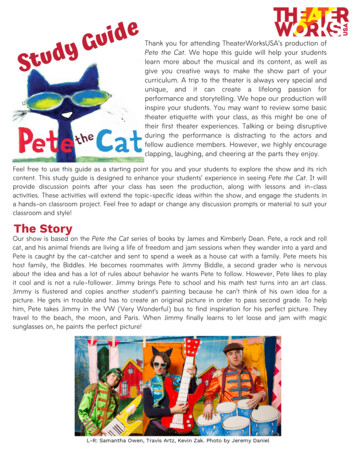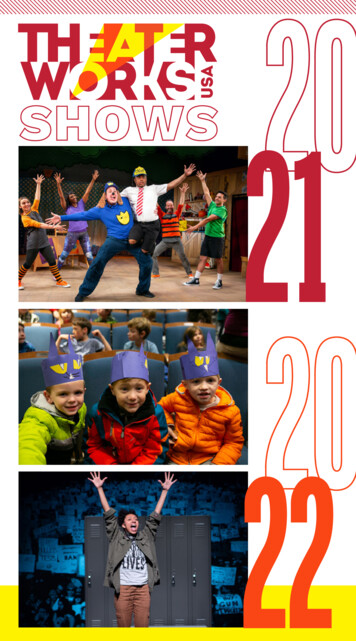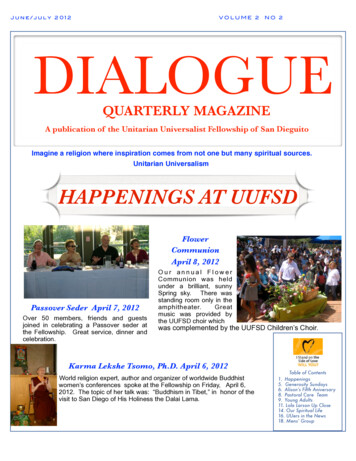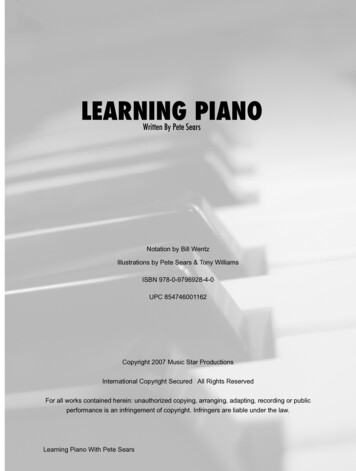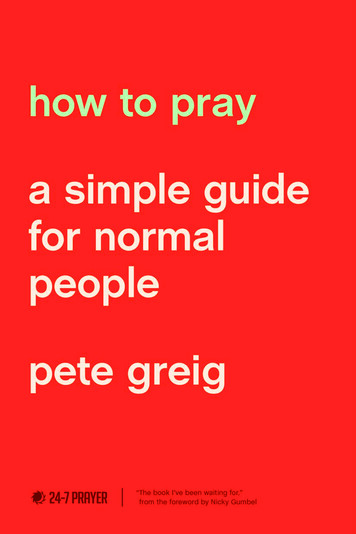
Transcription
Pete Greig has written the prayer masterpiece for today. How toPray emerges from the deep cavern of Pete’s own prayers andstruggles, his expansive study on prayer through the ages, and thediversity of prayer across his global friendships. How to Pray is aneasy-to-follow, easy-to-put-into-practice manifesto of prayer foreveryday life. Pete is, without question, one of the desperatelyneeded spiritual guides of our time.CRAIG SPRINGER, executive director of Alpha USA and author ofHow to Follow JesusIs there anything more primal than prayer? We reach out to God,and we hope God is reaching out to us in return. Pete Greig isunwilling to surrender this basic human impulse to any of thecultured complexities that we tend to build around it. With How toPray, he helps us enter a habit of prayer that is as life-giving as it issimple.IAN MORGAN CRON, author of The Road Back to YouPete Greig knows how to pray, and I’m so grateful for this book.His passion and fervor for intercession is contagious and hasinfluenced the church around the world. Get this book. Read thisbook. Live this book.BRADY BOYD, senior pastor at New Life Church and author of RemarkablePete Greig is a gift to the world. This book uses the revolutionaryprayer of Jesus as a grounded guide to ignite our spirits to pursuethe heart of God. As you read these pages, let these words infuseyou with a holy desire for God’s Kingdom to come!DANIELLE STRICKLAND, author of The Ultimate ExodusIf you’re like me, you may have prayed the Lord’s Prayer manytimes. It has staying power, doesn’t it? But that’s not surprising,because it’s how Jesus teaches us to pray. And it turns out that
when it comes to prayer, Jesus is a great teacher—for him, prayingis not fancy or formal but loving and plainspoken. Pete Greig is arespected authority on exactly this kind of praying: simple, honest,straightforward, from the heart. Even when we’re asking God forwhat we want, we’re giving him what he wants: our hearts. How toPray will get you started on a lifelong, and life-giving, practice.MARK BATTERSON, New York Times bestselling author of The Circle Makerand lead pastor of National Community ChurchIn a get-fixed-quick kind of world, Pete Greig meets us with thekind of guidance that’s both immediately accessible and deeplythoughtful. For everyone who’s wondered how to move theexperience of prayer from distant to personal and powerful, How toPray provides a starting point for new and seasoned believers alike.NICOLE UNICE, author of Help! My Bible Is Alive!For many years now, Pete Greig has been teaching us how to pray.Since the inadvertent start of the 24-7 Prayer movement nearly twodecades ago, Pete’s life and witness have been a provocation to thechurch to enter more deeply into the mystery, magnitude, agony,and beauty of prayer. In How to Pray: A Simple Guide for NormalPeople, Pete brings the best of two decades’ worth of insights to usin a deceptively straightforward and endearingly honest way. Savorthis book. Then put it into practice. Your life and your world willbe better for it.ANDREW ARNDT, associate and teaching pastor at New Life ChurchThe simplicity, clarity, and depth with which Pete talks aboutprayer is remarkable. Whatever barriers you’re facing when it comesto a vibrant prayer life, this book will help you move beyond themand walk into a richer relationship with Christ.MARGARET FEINBERG, speaker and author of Taste and See
how to praya simple guidefor normalpeoplepete greigA NavPress resource published in alliancewith Tyndale House Publishers, Inc.
NavPress is the publishing ministry of The Navigators, an i nternational C hristianorganization and leader in personal spiritual development. N avPress iscommitted to helping people grow spiritually and enjoy lives of meaningand hope through personal and group resources that are biblically rooted,culturally relevant, and highly practical.For more information, visit www.NavPress.com.How to Pray: A Simple Guide for Normal PeopleCopyright 2019 by Pete Greig. All rights reserved.A NavPress resource published in alliance with Tyndale House Publishers, Inc.NAVPRESS and the NAVPRESS logo are registered trademarks of NavPress, The Navigators, Colorado Springs,CO. TYNDALE is a registered trademark of Tyndale House Publishers, Inc. Absence of in connection withmarks of NavPress or other parties does not indicate an absence of registration of those marks.The Team:Don Pape, PublisherDavid Zimmerman, Acquisitions EditorElizabeth Schroll, Copy EditorDaniel Farrell, DesignerAuthor photo taken by Alex Douglas, copyright 2018. All rights reserved.Published in Great Britain by Hodder & Stoughton.All Scripture quotations, unless otherwise indicated, are taken from the Holy Bible, New InternationalVersion, NIV. Copyright 1973, 1978, 1984, 2011 by Biblica, Inc. Used by permission. All rightsreserved worldwide. Scripture quotations marked MSG are taken from THE MESSAGE, copyright 1993,1994, 1995, 1996, 2000, 2001, 2002 by Eugene H. Peterson. Used by permission of NavPress. All rightsreserved. Represented by Tyndale House Publishers, Inc. Scripture quotations marked NASB are taken fromthe New American Standard Bible, copyright 1960, 1962, 1963, 1968, 1971, 1972, 1973, 1975, 1977,1995 by The Lockman Foundation. Used by permission. Scripture quotations marked NLT are taken fromthe Holy Bible, New Living Translation, copyright 1996, 2004, 2015 by Tyndale House Foundation. Usedby permission of Tyndale House Publishers, Inc., Carol Stream, Illinois 60188. All rights reserved. Scripturequotations marked ESV are from the ESV Bible (The Holy Bible, English Standard Version ), copyright 2001 by Crossway, a publishing ministry of Good News Publishers. Used by permission. All rights reserved.Scripture quotations marked KJV are taken from the Holy Bible, King James Version.Some of the anecdotal illustrations in this book are true to life and are included with the permission of thepersons involved. All other illustrations are composites of real situations, and any resemblance to people livingor dead is purely coincidental.The lines from “Canal Bank Walk” by Patrick Kavanagh are reprinted from Collected Poems, editedby Antoinette Quinn (Allen Lane, 2004), by kind permission of the Trustees of the Estate of the lateKatherine B. Kavanagh, through the Jonathan Williams Literary Agency“Praying” from THIRST by Mary Oliver, published by Beacon Press, BostonCopyright 2006 by Mary OliverUsed herewith by permission of the Charlotte Sheedy Literary Agency, Inc.For information about special discounts for bulk purchases, please contact Tyndale House Publishers atcsresponse@tyndale.com, or call 1-800-323-9400.ISBN 978-1-64158-188-2Printed in the United States of America257246235224213202191
ContentsForewordxito Read This Book in a Couple of Minutes xiiiIntroduction: How to Make the Most of This Book xviiHowHow12Prayer Everywhere: Why Pray? 3Keeping It Simple: Starting Out in Prayer 15Step36793: AskPetition: How to Ask God 73Intercession: How to Ask God for Others 93Unanswered Prayer: How to Deal with Disappointment 113Step82: RejoiceAdoration: How to Worship God 51Step51: PauseSlowing and Centering: How to Be Still before God 35Step4to P.R.A.Y.4: YieldContemplation: How to Pray without Words 131Listening: How to Hear God 151
101112Confession and Reconciliation: How to Get Rightwith God 169Spiritual Warfare: How to Exercise Spiritual Authority 187Amen 213Howto Use This Book with The Prayer Course 223Toolshed: Index of Thirty Prayer Tools 225Further Reading and Recommended Resources 227With Thanks To 229Notes 231
Heroes of PrayerHero of Simple Prayer: Susanna Wesley— England 30Heroes of Slowing and Centering: The Desert Fathersand Mothers— Egypt46Hero of Adoration: Brother Lawrence— France 68Hero of Petition: Corrie ten Boom— Holland 91Hero of Intercession: Count Zinzendorf— Germany 110Hero of Unanswered Prayer: Joni Eareckson Tada— America127Hero of Contemplation: Blaise Pascal— France 148Hero of Listening: Amy Carmichael— India 167Hero of Confession and Reconciliation: Archbishop Desmond Tutu— South Africa184Hero of Spiritual Warfare: Saint Patrick— Ireland 211ix
ForewordI A M S O G L A D thatPete Greig has written this book. Prayer is themost important activity of our lives. It is the way in which we developa relationship with our Father in heaven. Jesus prayed and taught usto do the same. Prayer brings us peace, refreshes our souls, satisfiesour spiritual hunger, and assures us of our forgiveness. Prayer notonly changes us; it also changes situations. God answers prayer.But how should we pray?For many years, I have been hoping that someone would writea simple but comprehensive book on how to pray. The only ones Icould find were written decades ago and had not stood the test oftime.There seemed to be a big gap in the market. On the Alpha Course,we have a talk around week five on why and how to pray. We liketo recommend books but have struggled to find one to recommendrelating to this session about prayer. For the last few years, I haverecommended Pete’s earlier book God on Mute, but that is on a morespecialized aspect of prayer— why some prayers do not appear to beanswered. Nevertheless, I have recommended it because Pete is alegend in the world of prayer— having cofounded the 24-7 Prayer movement— and he combines his passion for prayer with a remarkable gift of writing.xi
How to PrayImagine my joy, then, when Pete told me he was writing a bookwith the title How to Pray. I was deeply honored when he then askedif I would write the foreword for it.Now, having read the manuscript, I find the book is everythingI longed for and more. This is a writer who knows what he’s talkingabout. He writes as he speaks— with great eloquence. He is articulatebut easily understood and immensely practical, illustrating his pointsbeautifully with interesting anecdotes, stories, and examples.Pete used to lead the prayers at our church, Holy TrinityBrompton, so I have personally experienced the power of Pete’s prayers— for myself and for our church, our nation, and the world.If, like me, you have tried leading corporate prayer, you will knowhow extraordinarily difficult it is to do it well. Pete always does it withconsummate skill— with humor but never with intensity; with powerand authority but also with a lightness of touch.This is indeed a book that does what it s ays— it explains how topray. I, for one, have been greatly helped by it already, and I’m sure thateveryone who reads it will be encouraged and helped to pray more like Jesus— and get to know God better.Here at last is a simple guide to prayer for normal people— thebook I have been waiting for.Nicky GumbelLondon, 2019xii
How to Read This Bookin a Couple of MinutesPA U S EYIELDOREJ ICEASKHow to P.R.A.Y. (Chapters 1–2)One of his disciples said to him,“Lord, teach us to pray!”Every pilgrim gets a stone in their shoe eventually. You wake up onemorning thinking, Is this really all there is to knowing the Creator ofone hundred billion galaxies? You read the book of Acts and ask, Whyisn’t it like that anymore? Your world falls apart and you desperatelyneed a miracle. You stare up at the stars and feel things bigger thanreligious language. You say to yourself, If this thing is true, there’s gotto be more power, more mystery, more actual personal experience. Andso, finally, you turn to God, half wondering whether you’re any morexiii
How to Praythan half- serious, and say, “Lord, teach me to pray.” And he replies,“I thought you’d never ask!”Pause (Chapter 3)[ Jesus] said . . . ,“When you pray, . . .”To start we must stop. To move forward we must pause. This isthe first step in a deeper prayer life: Put down your wish list andwait. Sit quietly. “Be still, and know that I am God.”1 Become fullypresent in place and time so that your scattered senses can recenterthemselves on God’s eternal presence. Stillness and silence prepareyour mind and prime your heart to pray from a place of greaterpeace, faith, and adoration. In fact, these are themselves importantforms of prayer.Rejoice (Chapter 4)Our Father in heaven, hallowed be your Name.No one stares up at the northern lights thinking, Wow, I’m incredible!We are hardwired to wonder and therefore to worship. The Lord’sPrayer begins with an invitation to adoration: “Our Father in heaven,hallowed be your Name.” Having paused to be still at the start ofa prayer time, the most natural and appropriate response to God’spresence is reverence. Try not to skip this bit. Hallowing the Father’sname is the most important and enjoyable dimension of prayer.Linger here, rejoicing in God’s blessings before asking for any more.Like an eagle soaring, a horse galloping, or a salmon leaping, worshipis the thing God designed you to do.xiv
How to Read This Book in a Couple of Minutes Ask (Chapters 5–7)Your kingdom come, your will be done. . . .Give us today our daily bread.Prayer means many things to many people, but at its simplest andmost immediate, it means asking God for help. It’s a soldier beggingfor courage, a soccer fan at the final, a mother alone in a hospitalchapel. The Lord’s Prayer invites us to ask God for everything from“daily bread” to the “kingdom come,” for ourselves (petition) and forothers (intercession). In this section, we explore the extraordinary, miracle- working power of prayer but also the questions we face whenour prayers go unanswered.Yield (Chapters 8–12)Forgive us our sins as we forgive those who sin against us. Leadus not into temptation but deliver us from evil. . . . Amen.The final step in the dance of prayer is surrender. It’s a clenchedfist slowly opening; an athlete lowering into an ice bath; a field ofCalifornia poppies turning to the sun. We yield to God’s presence“on earth as in heaven” through contemplative prayer and by listeningto his Word, which is “our daily bread.” We yield to God’s holinessthrough confession and reconciliation, praying, “Forgive us our sinsas we forgive those who sin against us.” And we yield to his powerin spiritual warfare, asking our Father to “deliver us from evil.” Andso, in all these ways, it’s by surrendering to God that we overcome,by emptying ourselves that we are filled, and by yielding our livesin prayer that our lives themselves become a prayer— the Lord’s Prayer— in the end.xv
IntroductionH O W TO M A K E T H E M O ST O F T H I S B O O KWith a God like this loving you,you can pray very simply. Like this . . .M AT T H E W 6 : 9, M S GW H E N O N E O F O U R S O N S heard that I was writing a book about howto pray, he said, “Oh, but that’s easy. You just say, ‘Dear God,’ chatto him for a bit, and then say, ‘Amen.’”In a way, he was right. Sometimes we make prayer way more complicated than it needs to be. How to Pray has been written as a simpleguide for normal people. It’s an introduction to a vast subject aimedat new Christians and ordinary followers of Jesus who may not havestudied theology and don’t consider themselves Jedi prayer warriors butwho would still like to grow and go a bit deeper in their relationshipwith God. It’s going to be a wild and wonderful journey of discovery. I am fortunate to live on the edge of open countryside where I oftenwalk through woodlands, around a golf course, or up to the top of ahill where you can see for thirty miles. There is a track that I followwhen I’m pushed for time or if it’s raining and I want to avoid theworst of the mud. But tangled around this main artery are veins and capillaries— secret tracks and overgrown trails more familiar to thebadger, fallow deer, and tawny owl than human feet.xvii
How to PrayI choose my path according to the weather, my schedule, or mymood. On sunny days, I tend to head into the hills to drink in thepanoramic views. In the autumn, I lose myself on thickly carpetedforest trails, foraging for puffballs and fairy- ring champignons. In thesummer, my family lights fires at dusk in hidden glades and sometimes camps wild.This book is a simple guide to the complex, living landscape ofprayer. Get your boots on— this isn’t going to be a concrete highway. Irealize there are times when we all just need the fastest possible route to God— when you’re skidding on your bike toward a parked car, you needthe most direct communication possible: “Help!” But there’s more toprayer than asking, and God is not in a hurry. There are ways of prayingthat are more like exploring than imploring: woodland trails on whichto shelter, places so beautiful you’ll stop and whisper praise. There aresecret, intimate places to camp, and paths that take you to the highlandsfor a longer view under a bigger sky. It’ll be an effort to climb, but worthit when you arrive.Along the way, we’re going to discover saints who’ve made theirhomes in particular aspects of this varied landscape. You’ll find theirstories throughout this book, with some featured as “Heroes” at theend of most chapters. Some have camped out in contemplation.Others have built hides in the treetops of prophetic insight. You willeventually find your own favorite terrain in your walk with God.I must warn you, however, that none of these trails lead to God.That’s just not how it works. There’s no one superior way to pray. Ifyou’re searching for the Holy Grail, go back to where you began. Butas you set out on the many paths of prayer, the Lord is going to joinyou on the journey. (He’s putting his boots on right now.) He’s goingto walk in silence with you and talk with you too. The conversationwill ebb and flow. He will tell you things you never knew and askyou things you’ve never told. Occasionally you’ll lose your sense ofxviii
Introductionhim, but not for long. Sometimes he will suggest a rest or a particularpath, but mostly he will follow your lead, accompanying you everystep of the way until eventually you come full circle, arriving home,knowing yourself known.We’re taking a map with us, of course. The world’s most famous prayer— the Lord’s P rayer— was given to us by Jesus himself for thisvery purpose: to “teach us to pray.” In these old, familiar words we aregoing to discover nine different paths of prayer: Stillness, Adoration,Petition, Intercession, Perseverance, Contemplation, Listening,Confession, and Spiritual Warfare.Our journey is going to be paced around an easy, f our- step rhythm:P.R.A.Y.—Pause, Rejoice, Ask, Yield. I’m not a big fan of a cronyms— they smack of science textbooks and o ver earnest sermons— but thisparticular one just works, because it’s simple, sensible, and sneakilyprofound. Try not to take its four steps as hard- and- fast rules— rungson a ladder to some seventh heaven. They are more like dance steps:fluid, interactive, and open to creative interpretation. Give P.R.A.Y. achance and it’ll lend your prayer life a light structure and an easy flow,whether you’re on your own or praying in a group (although withchildren, you may want to swap that tricky word “Yield” for “Yes”). I’ve been writing this book for the best part of two decades, ever sincea couple of important discoveries inadvertently launched the 24-7Prayer movement.The first was that prayer is actually, surprisingly, pretty much themost important thing in life.The second was that my friends and I were horribly bad at it.Since that inauspicious start, we’ve been on an adventure of exploration into this simple, difficult, inevitable thing that beats at thexix
How to Prayheart of life and faith and culture. The teaching in this book flows,therefore, not so much from libraries, seminaries, and polished pulpits, but from the practical discoveries we’ve made praying night andday in hundreds of pop- up prayer rooms over the last twenty years.You can read How to Pray on its own— it’s a stand- alone product— but also as a companion volume to The Prayer Course, a free online program for small groups that uses videos and discussion starters to applydifferent aspects of the Lord’s Prayer to daily life. As I’ve indicated,at the end of each chapter, you’ll find a “Hero of Prayer” whose lifeexemplifies the particular type of prayer we’ve been studying, as well aslinks to additional online resources available at www.prayercourse.org: Toolshed: Index of Thirty Prayer Tools— to help you practicethis kind of prayer; and The Prayer Course Video— relating to each chapter, including aguide for group discussion.xx
PA U S EYIELDOREJ ICEASKHOW TO P.R.A.Y.One day Jesus was praying in a certain place. Whenhe finished, one of his disciples said to him, “Lord,teach us to pray, just as John taught his disciples.”LUKE 1 1:1Every pilgrim gets a stone in their shoe eventually. You wake up onemorning thinking, Is this really all there is to knowing the Creator ofone hundred billion galaxies? You read the book of Acts and ask,Why isn’t it like that anymore? Your world falls apart and you desperately need a miracle. You stare up at the stars and feel thingsbigger than religious language. You say to yourself, If this thing istrue, there’s got to be more power, more mystery, more actual personal experience. And so, finally, you turn to God, half wonderingwhether you’re any more than half- serious, and say, “Lord, teachme to pray.” And he replies, “I thought you’d never ask!”
1Prayer EverywhereW H Y P R AY ?One day Jesus was praying in a certain place.LUKE 1 1:1More things are wrought by prayerThan this world dreams of. Wherefore, let thy voiceRise like a fountain for me night and day.ALFRED LORD TENNYSON,I DY L LS O F T H E K I N GO N M O U N T AT H O S , twothousand meters above the Aegean Sea, big- bearded Orthodox monks are praying, as they have done for1,800 years. About eleven miles north of Lagos, more than a millionNigerian Christians are gathering for a monthly prayer meeting atthe vast campus of The Redeemed Christian Church of God. On thebanks of the River Ganges at Varanasi, Hindu pilgrims are plunginginto the sacred waters seeking cleansing and hope. Somewhere inManhattan, a group of addicts on a twelve- step program is seeking“through prayer and meditation to improve our conscious contactwith God.”1 High in the Himalayas, bells are chiming, and strings ofcolored prayer flags are dancing against sapphire skies. Deep in theforests of giant Redwood and Douglas fir on California’s Lost Coast,Cistercian nuns are keeping vigil beside the Mattole River, wheresalmon and steelhead swim.3
How to PrayOne person in every four prays the Lord’s Prayer each year onEaster Day alone. One person in every six bows toward Mecca upto five times a day. Hasidic Jews stand at Jerusalem’s Wailing Walldressed in black and rocking to and fro like aging goths at a silentdisco. In front of them, between the giant stones of Herod’s Temple,thousands of handwritten prayers are wedged like badly rolled cigarettes between the bricks.It’s worth pausing at the start of a book like this to acknowledgethe unending chorus of human longing: a canticle of sighs and criesand chiming bells, mutterings in maternity wards, celestial oratorios,and scribbled graffiti. In the words of Abraham Heschel, “Prayer isour humble answer to the inconceivable surprise of living.”2Native LanguageOur English word prayer derives from the Latin precarius. We praybecause life is precarious. We pray because life is marvelous. We praybecause we find ourselves at a loss for many things, but not for thesimplest words like “please,” “thank you,” “wow,” and “help.” I prayedwhen I held our babies for the first time. I prayed when work overwhelmed me, and I knew I couldn’t cope. I prayed when my wife waswheeled away down the hospital corridor unconscious. I prayed thenight I saw the northern lights.Canadian psychologist David G. Benner describes prayer as “thesoul’s native language,” observing that “our natural posture is attentive openness to the divine.”3 We see this posture in many great menand women not necessarily known for religious devotion. AbrahamLincoln admitted, “I have been driven many times upon my kneesby the overwhelming conviction that I had nowhere else to go. Myown wisdom . . . seemed insufficient for that day.”4Conrad Hilton, founder of the eponymous hotel chain, devotes4
Prayer Everywherethe last section of his autobiography to the matter of prayer. “In thecircle of successful living,” he explains, “prayer is the hub that holdsthe wheel together.”5In her semiautobiographical novel One True Thing, AnnaQuindlen depicts the agony of being nineteen years old and watching her mother receive chemotherapy “drop by drop by G od- please- let- it- work drop. Oh yes, I prayed in that cubicle and in the hallwayoutside and in the cafeteria,” she says. “But I prayed to myself, without form, only inchoate feelings, one word: please, please, please,please, please.”6Rock star Dave Grohl admits to praying desperately when hisdrummer, Taylor Hawkins, overdosed at England’s V Festival. “I wouldtalk to God out loud as I was walking,” he recalls of the late- nightstrolls back to Kensington’s Royal Garden Hotel from the hospitalwhere his friend lay in a coma. “I’m not a religious person but I wasout of my mind, I was so frightened and heartbroken and confused.”7Early in Elizabeth Gilbert’s bestselling memoir Eat, Pray, Love, shewrites: “Hello, God. How are you? I’m Liz. It’s nice to meet you. . . .I haven’t ever spoken directly to you before.” And then she starts tocry. “Can you please help me? I am in desperate need of help. I don’tknow what to do.” As her tears subside, she experiences a peace “sorare,” she says, “that I didn’t want to exhale, for fear of scaring itoff. . . . I don’t know when I’d ever felt such stillness. Then I heard avoice. . . . It was not an Old Testament Hollywood Charlton Hestonvoice, nor was it a voice telling me I must build a baseball field in mybackyard. It was merely my own voice. . . . But this was my voice asI had never heard it before.”8My friend Cathy was a militant atheist at the University ofWichita when, late one night in her lodgings, gazing down at hersleeping baby, she was overwhelmed with a desire to give thanks tosomeone or something for this gift of all gifts. Without a husband5
How to Prayor a boyfriend in her life with whom to share her sense of wonder,Cathy whispered a few s elf- conscious words of gratitude out into thesilence. As she did so, the atmosphere seemed to change. Wave uponwave of love, unlike anything she had ever experienced, came flooding into the room. Kneeling there that night beside her sleeping baby,Cathy relinquished her ardent atheism. More than thirty years later,she remains a follower of Jesus.Irish poet Patrick Kavanagh found himself similarly moved topray by life’s unfathomable wonder, an impulse he describes in hispoem “Canal Bank Walk” as “the gaping need of my senses”:O unworn world enrapture me, encapture me in a webOf fabulous grass and eternal voices by a beech,Feed the gaping need of my senses, give me ad libTo pray unselfconsciously with overflowing speech,For this soul needs to be honoured with a new dress wovenFrom green and blue things and arguments that cannot be proven.9To Be Human Is to PrayFrom American presidents to Irish poets, from rock stars in Londonto single mothers in Wichita, prayer has been the argument “thatcannot be proven,” the “gaping need” of every human soul since thevery dawn of time. Cave paintings dating back more than thirtyfive thousand years at Maros in Indonesia and Chauvet in Francefunctioned, it is thought, as spiritual invocations. In modern Turkey,the hilltop ruins at Göbekli Tepe are reckoned to be the remains ofa temple six thousand years older than Stonehenge, which may itselfhave been a place of prayer some three thousand years before Christ.And what of the future? Is prayer just the diminishing shadowof some primitive dawn? Survey after survey answers no.10 Three6
Prayer Everywherehundred years after the Enlightenment the world is, if anything,becoming more religious, not less.11 I am based in England, considered to be one of the more secular nations in Western Europe, buteven here, one quarter of those who describe themselves as “nonreligious” admit that they “take part in some spiritual activity eachmonth, typically prayer.”12Eminent surgeon David Nott illustrates this apparent contra diction well. He operates in three British hospitals but chooses tospend his holidays in the world’s most dangerous war zones. “I amnot religious,” he assured Eddie Mair in an interview:But every now and again I have to pray and I do pray toGod and I ask him to help me because sometimes I amsuffering badly. It’s only now and again that I am able toturn to the right frequency to talk to him and there is nota doubt in my mind there is a God. I don’t need him everyday. I need him every now and again but when I do needhim he is certainly there.13That interview in its entirety had a profound effect on its listeners. In fact, experimental artist Patrick Brill (better known by hisstrange pseudonym “Bob and Roberta Smith”) was so moved byNott’s testimony that he spent the next four months transcribingevery single word, letter by letter, onto a vast canvas which was thenhung in the central hall of London’s Royal Academy as the centerpiece of its Summer Exhibition— the most popular annual display ofcontemporary art in the country and the oldest in the world.From primitive cave paintings to the whitewashed walls of theRoyal Academy, the universal impulse to pray permeates and pulsatesthrough human anthropology and archaeology, sociology and psychology. It is no exaggeration to say that to be human is to pray. The7
How to Prayquestion, therefore, is not so much why we pray, but rather how andto whom. For billions of people today, the answer to such questionsis to be found in the revolutionary life and teaching of Jesus Christ.The Bible and PrayerVery
NavPress is the publishing ministry of The Navigators, an international Christian organization and leader in personal spiritual development. NavPress is committed to helping people grow spiritually and enjoy lives of meaning and hope through personal and group resources that are biblically rooted, culturally relevant, and highly practical.
